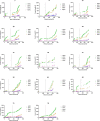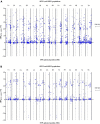Pentaploidization Enriches the Genetic Diversity of Wheat by Enhancing the Recombination of AB Genomes
- PMID: 35845672
- PMCID: PMC9281561
- DOI: 10.3389/fpls.2022.883868
Pentaploidization Enriches the Genetic Diversity of Wheat by Enhancing the Recombination of AB Genomes
Abstract
Allohexaploidization and continuous introgression play a key role in the origin and evolution of bread wheat. The genetic bottleneck of bread wheat resulting from limited germplasms involved in the origin and modern breeding may be compensated by gene flow from tetraploid wheat through introgressive hybridization. The inter-ploidy hybridization between hexaploid and tetraploid wheat generates pentaploid hybrids first, which absorbed genetic variations both from hexaploid and tetraploid wheat and have great potential for re-evolution and improvement in bread wheat. Therefore, understanding the effects of the pentaploid hybrid is of apparent significance in our understanding of the historic introgression and in informing breeding. In the current study, two sets of F2 populations of synthetic pentaploid wheat (SPW1 and SPW2) and synthetic hexaploid wheat (SHW1 and SHW2) were created to analyze differences in recombination frequency (RF) of AB genomes and distorted segregation of polymorphic SNP markers through SNP genotyping. Results suggested that (1) the recombination of AB genomes in the SPW populations was about 3- to 4-fold higher than that in the SHW populations, resulting from the significantly (P < 0.01) increased RF between adjacent and linked SNP loci, especially the variations that occurred in a pericentromeric region which would further enrich genetic diversity; (2) the crosses of hexaploid × tetraploid wheat could be an efficient way to produce pentaploid derivatives than the crosses of tetraploid × hexaploid wheat according to the higher germination rate found in the former crosses; (3) the high proportion of distorted segregation loci that skewed in favor of the female parent genotype/allele in the SPW populations might associate with the fitness and survival of the offspring. Based on the presented data, we propose that pentaploid hybrids should increasingly be used in wheat breeding. In addition, the contribution of gene flow from tetraploid wheat to bread wheat mediated by pentaploid introgressive hybridization also was discussed in the re-evolution of bread wheat.
Keywords: adaptive evolution; chromosome recombination; genetic bottleneck; linkage drag; pentaploid.
Copyright © 2022 Yang, Wan, Li, Wang, Yang, Zhu, Liu, Yang, Ma, Fan, Yang and Zhou.
Conflict of interest statement
The authors declare that the research was conducted in the absence of any commercial or financial relationships that could be construed as a potential conflict of interest.
Figures





Similar articles
-
Pentaploid Wheat Hybrids: Applications, Characterisation, and Challenges.Front Plant Sci. 2017 Mar 17;8:358. doi: 10.3389/fpls.2017.00358. eCollection 2017. Front Plant Sci. 2017. PMID: 28367153 Free PMC article. Review.
-
The Use of Pentaploid Crosses for the Introgression of Amblyopyrum muticum and D-Genome Chromosome Segments Into Durum Wheat.Front Plant Sci. 2019 Sep 18;10:1110. doi: 10.3389/fpls.2019.01110. eCollection 2019. Front Plant Sci. 2019. PMID: 31620148 Free PMC article.
-
Improvement and Re-Evolution of Tetraploid Wheat for Global Environmental Challenge and Diversity Consumption Demand.Int J Mol Sci. 2022 Feb 17;23(4):2206. doi: 10.3390/ijms23042206. Int J Mol Sci. 2022. PMID: 35216323 Free PMC article. Review.
-
A breeding strategy targeting the secondary gene pool of bread wheat: introgression from a synthetic hexaploid wheat.Theor Appl Genet. 2019 Aug;132(8):2285-2294. doi: 10.1007/s00122-019-03354-9. Epub 2019 May 3. Theor Appl Genet. 2019. PMID: 31049633
-
Retention of D genome chromosomes in pentaploid wheat crosses.Heredity (Edinb). 2011 Oct;107(4):315-9. doi: 10.1038/hdy.2011.17. Epub 2011 Mar 23. Heredity (Edinb). 2011. PMID: 21427754 Free PMC article.
Cited by
-
Association Analysis of Tiller-Related Traits with EST-SSR Markers in Psathyrostachys juncea.Genes (Basel). 2023 Oct 21;14(10):1970. doi: 10.3390/genes14101970. Genes (Basel). 2023. PMID: 37895319 Free PMC article.
-
Genetic Improvement and Application Practices of Synthetic Hexaploid Wheat.Genes (Basel). 2023 Jan 21;14(2):283. doi: 10.3390/genes14020283. Genes (Basel). 2023. PMID: 36833210 Free PMC article. Review.
-
Genomic Divergence Shaped the Genetic Regulation of Meiotic Homologous Recombination in Brassica Allopolyploids.Mol Biol Evol. 2025 Apr 1;42(4):msaf073. doi: 10.1093/molbev/msaf073. Mol Biol Evol. 2025. PMID: 40173423 Free PMC article.
-
Alternating between even and odd ploidy levels switches on and off the recombination control, even near the centromeres.Plant Cell. 2024 Oct 3;36(10):4472-4490. doi: 10.1093/plcell/koae208. Plant Cell. 2024. PMID: 39121028 Free PMC article.
References
-
- Aberkane H., Payne T., Kishi M., Smale M., Amri A., Jamora N. (2020). Transferring diversity of goat grass to farmers’ fields through the development of synthetic hexaploid wheat. Food Secur. 12 1017–1033.
-
- Anderson E. (1949). Introgressive Hybridization. New York, NY: John Wiley and Sons, Inc.
LinkOut - more resources
Full Text Sources
Miscellaneous

